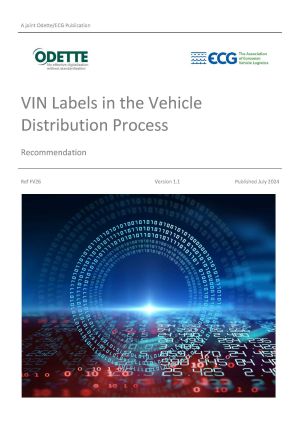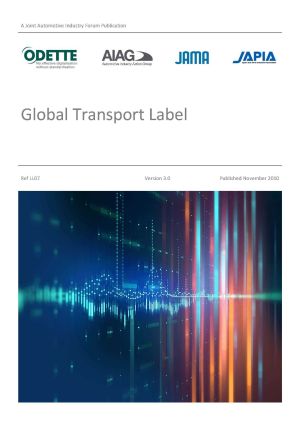Auto-ID
Linking the physical to the digital


About
Auto-ID is one of the most widely used methodologies in the automotive supply chain, where the processing of a large number of objects requires fast tracking beyond human capability and capacity.
Together with EDI, it was one of the first methodologies embraced by the fledgling Odette organisation in the 1980s when we developed the Odette Transport Label (OTL) incorporating barcode technology. This original label is still in wide use across the industry today, although more and more companies are migrating to the more recent Global Transport Label (GTL) developed jointly by Odette and AIAG. This latter label also incorporates other auto-ID technologies such as 2D Symbology and RFID tags.
Auto-ID technologies bring efficiencies to four basic logistics processes: shipping, transportation, receiving and in-house operations. Automotive companies now leverage a combination of RFID tags and readers, barcode labels and long-range mobile scanners to increase the speed and ease of data collection and improve the tracking of assets.
Integrated in ERP, MRP and PEM software systems, auto-ID technologies improve the speed and accuracy of processes, including locating, retrieving, and accounting for anything that moves in, out or through any type of automotive facility and the increased availability of data provides a basis for strategic improvements and a re-engineering of the automotive supply chain.
News
-

news
The new Odette GTL Generator. Successful labelling everytime!
12 May 2023
An increasing number of OEMs and Tier1 suppliers are requiring their suppliers to implement the GTL however not all suppliers have the appropriate back-end systems to produce these labels to the correct specification consistently.
-
news
Size matters for the Global Transport Label
02 Mar 2023
The automotive industry is increasingly moving to smaller pack quantities, for both deliveries and trackside storage, which has led to more and more tray and blister packaging being used. These very small packaging sizes pose particular challenges for labelling even with the small load container labels already specified by Odette. To meet these challenges, the Odette Technology Group has designed two even smaller labels which can carry the main data items of the Global Transport Label.
-

news
New tool accelerates the logistics flow for finished vehicles
09 Jan 2023
ECG and Odette have come together to develop a ground-breaking standard for VIN labels to help overcome inefficiencies in the process of delivering finished vehicles to its final destination. And it’s already under deployment by Volvo Cars worldwide.
Barcoding
The original Odette Transport label uses Code 39 linear barcodes (ISO/IEC 16388) but for the more recent Global Transport Label (GTL) the higher density Code 128 linear barcode (ISO/IEC 15417) is used, which allows the coding of all 128 ASCII characters. The higher density of Code 128 also makes the reading of the barcode more reliable.
The GTL also incorporates the option to use 2D barcodes and, in this case, we have chosen to specify the Data Matrix symbology (ISO/IEC 16022) rather than the QR symbology which will be familiar to mobile phone users. The Data Matrix barcode supports advanced encoding error checking and correction algorithms and has a slightly higher information capacity. This allows the recognition of barcodes that are up to 60 percent damaged so is particularly suited to the automotive supply chain where barcodes on paper labels are easily damaged.
Data Matrix barcodes are also adaptable in size, allowing alignment with smaller labels, e.g., on individual products or small packages.
GTL Generator
An increasing number of OEMs and Tier1 suppliers are requiring their suppliers to implement the European Profile of the Global Transport Label (GTL) as specified in Odette Recommendation LL08 (VDA 4994). Not all suppliers, however, have the appropriate back-end systems to produce these labels to the correct specification consistently*.
Odette has therefore developed a simple tool that can generate compliant GTLs from a simple CSV input. The labels are generated as PDF files which can be printed with a large variety of ordinary laser printers or specialised label printers.
The Odette GTL Generator is available free of charge as a portable app.
* The data content as agreed in purchasing contracts/logistics agreements remains the responsibility of the user.

Odette GTL Generator (Windows)
Tool provided by Odette to generate Global Transport Labels (Odette Profile) that meet the standard Odette LL08 (VDA 4994).
Sizes currently supported:
A5 (210mm x 148mm)
A6 (148mm x 105mm)
SLC1 (210mm x 74mm)
Contact us if you require any additional sizes that are specified in LL08.
RFID
RFID is not a new technology. Many OEMs and part suppliers started RFID projects in the early 2000s, in areas as varied as production control, production means tracking, tooling monitoring and vehicle logistics but it did not always meet expectations in terms of both cost and level of performance.
However, since the late 2010s, RFID has made tremendous progress. In the past 10 years the cost of RFID tags has been divided by 10 and the number of tags which can be read simultaneously has been multiplied by 100, which has now made RFID viable as an auto-ID technology throughout the whole automotive supply chain.
The RFID recommendations developed by Odette and our JAIF colleagues are completely based on ISO standards. They offer comprehensive descriptions of technical topics (e.g., structure and content of RFID memory banks…), highlight dedicated recommendations made by the automotive industry and provide a broad description of use cases applicable in the industry.
When the first RFID requirements started to appear in RFQs, it was necessary to go deeper and facilitate the development of processes based on RFID, especially those involving several partners in the supply chain, before numerous heterogeneous and incompatible industrial implementations took place.
The latest Odette recommendation covers several logistics and supply chain use cases in more detail. It focuses on practical issues and describes best practices for implementing and deploying an RFID enabled infrastructure in supply chain and intra-company logistics processes.
In terms of technology, many contactless radio frequency technologies are available and can reasonably be applied in specific use cases but the Odette recommendation focuses on Passive UHF (Ultra High Frequency) RFID technology.
Resources

Implementing RFID in the Automotive Supply Chain
This recommendation aims to help the automotive industry, project leaders and users, and external technology integrators or vendors to implement RFID processes across different partners of the supply chain, in order to obtain good interoperability and avoid multiple solutions that could become a blocking point for industry suppliers.
The document covers different logistics and supply chain use cases, some of which are described in more detail in related annexes. It focuses on issues which contribute to defining common standards for a better interoperability between the partners involved.In terms of technology, many contactless radio frequency technologies are available and can justly be applied in specific use cases. In order to simplify the recommendations, this document focuses on Passive UHF (Ultra High Frequency) RFID technology.

RFID for Tracking of Parts and Assemblies
This Odette recommendation describes the processes and methods of tracking and tracing of vehicle parts and enabling the authentication of original parts using RFID technology. It has been developed to move towards achieving widespread standardisation of RFID component usage, tag data storage and RFID technology implementation across supply chains.

RFID in Vehicle Distribution Processes
This Odette recommendation describes the processes and methods of tracking and tracing vehicles in the distribution processes from factory to dealer using RFID technology and a smart label. It has been developed to move towards achieving widespread standardisation of RFID component usage, tag data storage and RFID technology implementation across vehicle distribution chains.

Returnable Transport Items Identification
Version 3 published March 2021. RFID technology has been widely adopted by the automotive industry in individual organisations due to the efficiency and security gains it delivers. However, widespread use between companies is currently much rarer due to compatibility issues. In response to this, Odette, AIAG, JAMA and JAPIA have jointly developed recommendations for RFID use in Returnable Transport Items Identification. The aim is to help moves toward the creation of general purpose global guidelines and accelerate further international adoption of RFID solutions.

RFID Item Level Standard
Version 3 published March 2021. This Radio Frequency Identification (RFID) Item Level Standard describes best practices, processes, and methods for item identification, verification, traceability, product characteristics, and Vehicle Identification Number (VIN) throughout the global automotive supply chain. Extensive efforts have been made by the automotive industry to incorporate interchangeable data use between 2D optical symbols and electronic media such as RFID. This publication gives standards for the implementation and use of RFID in such applications and was jointly produced by Odette, AIAG, JAMA and JAPIA.

Capturing Supply Chain Events with auto-ID
To achieve process transparency, machine-readable objects and ways of tracking these objects along the process chain need to be defined and implemented. The Odette Recommendations LR01, LR02, LR03, LR04 and LR05 outlined the foundations and the next logical step is the implementation of standardised communication with all business partners across company boundaries, based on international standards he Odette Recommendation “Capturing Supply Chain Events with auto-ID” addresses this issue.

Global Transport Label - Odette Profile
(previously published as European Profile)
Members of the JAIF combined the best features from their own label standards – including ISO 15394, ANSI MH10.8.1, the Odette Transport Label and the AIAG B-10 to produce a standard Global Transport Label which includes features such as the ISO “Licence plate,” Linear Bar Code 128 and 2D Data Matrix, QR Code and PDF417. Based on this standard, an Odette profile has been further developed and maintained.

VIN Labels in the Vehicle Distribution Process
Developed by Odette and ECG, this recommendation has the following objectives:
- Define a standard location and fixing method for the vehicle identification label
- Recommend a size and layout for the vehicle identification label
- Define a minimum content for the vehicle identification label
- Recommend a bar-coding standard
- Provide recommendations for the quality of the vehicle identification label

Global Transport Label
This document details common Global Transportation Label standards on container-labelling for use by suppliers and customers, and has been updated to include Data Matrix and QR code 2D symbologies. It was developed by collaboration between the members of Odette, AIAG and JAMA automotive associations representing more than 80% of worldwide production.

Odette Transport Label - Large (OTL1)
This is the original A5 Odette Transport Label (210mm x 102mm) which is designed to be used on product packaging units and transport packaging units sent between supplier and customer. First introduced in the 1980s, this label spec has been updated several times and is still in widespread use in the automotive industry today.

Odette Transport Label - Small (OTL3)
This Odette label (210mm x 74mm) was introduced to allow its use on smaller units where the original A5 label was too large. It also allows for the inclusion of additional logistics information to facilitate the automated movement of product packaging units from warehouse to trackside.

Traceability of Vehicle Components
The extended supply chains of automotive businesses require accurate and efficient traceability of parts and components across several layers. But to ensure that components can be traced properly throughout different organisations and systems, an element of standardisation of tracking processes is needed. This document includes a variety of standardised processes for implementing component traceability and identifying technical specifications.

JAIF Data Identifiers for Use in AutoID
The JAIF* has created a separate table of the ANSI MH10.8.2 Data Identifiers that are actually in use in automotive AutoID applications or are referenced in the various AutoID Recommendations that have been published, either jointly or independently, by JAIF members.
The table of JAIF Data Identifiers is a subset of the full list of Data Identifiers specified in the Data Identifiers standard ANSI MH10.8.2 which is published and maintained by the MH10 Committee for Unit Loads and Transport Packages of MHI.
* Joint Automotive Industry Forum = AIAG, JAMA/JAPIA and Odette

Odette GTL Generator (Windows)
Tool provided by Odette to generate Global Transport Labels (Odette Profile) that meet the standard Odette LL08 (VDA 4994).
Sizes currently supported:
A5 (210mm x 148mm)
A6 (148mm x 105mm)
SLC1 (210mm x 74mm)
Contact us if you require any additional sizes that are specified in LL08.

Odette GTL Generator (Linux)
Tool provided by Odette to generate Global Transport Labels (Odette Profile) that meet the standard Odette LL08 (VDA 4994).
Sizes currently supported:
A5 (210mm x 148mm)
A6 (148mm x 105mm)
SLC1 (210mm x 74mm)
Contact us if you require any additional sizes that are specified in LL08.